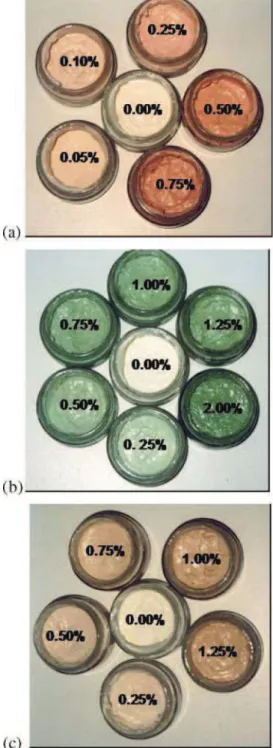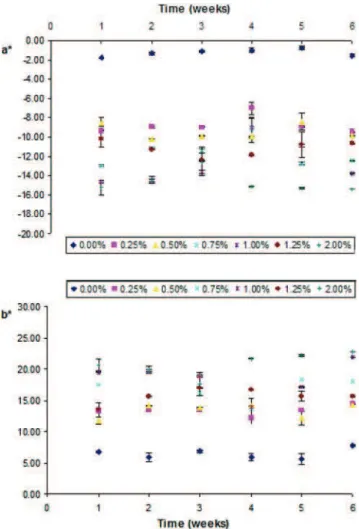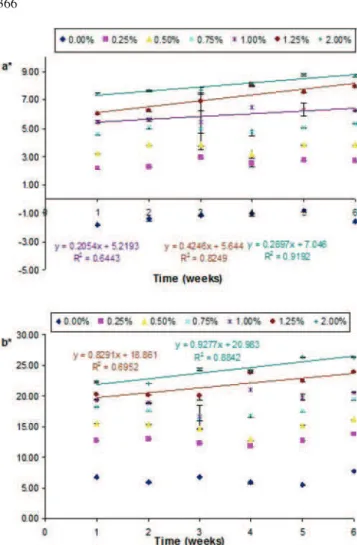DOI 10.1007/s00217-005-0105-z O R I G I NA L PA P E R
Lu´ısa Gouveia · Anabela Raymundo ·
Ana Paula Batista · Isabel Sousa · Jos´e Empis
Chlorella vulgaris and Haematococcus pluvialis biomass
as colouring and antioxidant in food emulsions
Received: 29 March 2005 / Revised: 1 July 2005 / Accepted: 5 July 2005 / Published online: 28 September 2005 C
° Springer-Verlag 2005
Abstract The use of microalgal biomass, a natural ingredi-ent, to colour oil-in-water pea protein stabilised emulsions was studied. Various levels of incorporation ofChlorella vulgaris green, Chlorella vulgaris orange (after caroteno-genesis), andHaematococcus pluvialis (red, after caroteno-genesis) were used, resulting in a wide range of appealing colours from green to orange and pink. The colour stability of the emulsions was evaluated, through the evolution of the L∗a∗b∗parameters (CIELAB system) along 6 weeks. The
primary and secondary oxidation products of the emulsions were also determined, and an enhanced resistance to oxi-dation was evidenced by emulsions containing microalgae. Therefore antioxidant functionality was another positive aspect of its use as an ingredient. Colour stability, a va-riety of attractive hues, and added resistance to oxidation ensure an adequate compromise of sensory and functional properties for these novel emulsions.
Keywords Microalgæ . Chorella vulgaris . Haematococcus pluvialis . Emulsions . Colouring . Oxidation
L. Gouveia (*)
Instituto Nacional de Engenharia e Tecnologia Industrial -INETI-DER- Unidade Biomassa, Estrada do Pac¸o do Lumiar, 1649-038 Lisboa, Portugal
e-mail: luisa.gouveia@ineti.pt Tel.: +351-21-7127210 Fax: +351-21-7127195 A. Raymundo · A. P. Batista
Instituto Piaget, Centro de Investigac¸˜ao em Eng Alimentar e Biotecnologia, ISEIT de Almada, Quinta da Arreinela de Cima, 2800-305 Almada
I. Sousa
Secc¸˜ao de Ciˆencia e Tecnologia dos Alimentos, Instituto Superior de Agronomia, Universidade T´ecnica de Lisboa, Tapada da Ajuda,
1349-017 Lisboa, Portugal J. Empis
Centro de Eng Biol´ogica e Qu´ımica, IST, Av. Rovisco Pais, 1049-001 Lisboa, Portugal
Introduction
Modern food industry aims at an increase of cheaper, healthier and more convenient foods. The use of natural ingredients with functional activity is an attractive way to design new foods with an important impact on new markets niche.
Oil-in-water emulsions, such as mayonnaises and salad dressings, were traditionally stabilised by egg yolk lipoteins. This protein can be fully replaced by vegetable pro-tein isolates, as it was successfully tested [1,2]. The main advantages of this substitution results from the growing in-terest on low-cholesterol and animal-free food emulsions, low fat and easier to handle with an expected positive agri-cultural impact [1].
Besides health aspects, sensory characteristics are deter-minant for consumer acceptability, image, market size and commercial value. Colour, texture, shape and size are the important criteria as indicators of quality and freshness of food. In the past, synthetic pigments were thoroughly used to manipulate food colour. However, at present the prior-ity is to replace artificial (synthetic) by natural colourings [3].
Microalgal biomass is a natural purveyor of biologically active compounds, such as carotenoids, phycobilins, fatty acids, polysaccharides, vitamins and sterols. Due to its con-tent in natural pigments, especially of carotenoid nature, microalgal biomass can be used as colouring agent [4–7]. The harvesting time of microalgal biomass, cultivated in appropriate growth medium, determines a possible range of hues and colours, which can be monitored in terms of visible absorption spectrum [8]. It means that when the desired colour is “green”, microalgal biomass harvesting should be very early; however, when the desired colour is “orange-red”, carotenogenesis must progress over time and biomass harvesting must be performed on a latter stage.
In previous studies it has been observed that the incor-poration of microalgal biomass in food emulsions does not destabilise its structural properties, and could even present a synergistic effect, increasing e.g. emulsions firmness;
and reducing the oil content of the emulsion without dis-turbing their structural and sensory properties [9].
Lipid oxidation is a major cause for quality loss in food emulsions [10] due to the formation of undesirable volatile compounds, off-flavours (rancidity) and potentially toxic reaction products [11] which makes the emulsions less ac-ceptable to consumers [12]. Besides colour, carotenoid pig-ments, under certain conditions, can retard lipid oxidation (antioxidants) in an array of lipid substrates [13,14], which can be very advantageous when they are used as ingredients of high fat food products (e.g. mayonnaises). Microalgal biomass may be considered as multi-component antioxi-dant systems, which are generally more effective due to synergistic or additive interactions between the different antioxidant components [15,16].
The mechanism that explains the performance of antiox-idants in multiphase systems differs from that of inhibited lipid oxidation in bulk oils due to more complex interfacial phenomena that are expected to affect the antioxidant ac-tivity [10]. The portioning of antioxidant, between the lipid and aqueous phase, and consequently their efficacy, may be influenced by factors such as charge, interactions with the emulsifier and pH [10].
The aim of this work was to evaluate the ability of mi-croalgal biomass to act as a pigment and as an antioxidant agent in food emulsions. Two microalgae were used— Chlorella vulgaris (green and orange, after carotenogen-esis) andHaematococcus pluvialis (red, carotenogenic) as colouring and antioxidant source for oil/water food emul-sions stabilised by a pea protein interface. Hue and colour intensity (CIELAB system) of emulsions were determined as a function of pigment concentration. The antioxidant ef-fect was evaluated over 6 weeks by determining primary and secondary oxidation products, respectively by peroxide value andp-anisidine value assessment.
Materials and methods Microalgæ
Chlorella vulgaris (INETI 58) (Cv) and Haematococ-cus pluvialis (INETI 33) (Hp) were used in this study. The microalgæ were cultivated in appropriated growth medium [17] and after growing in airlift bioreactors, bub-bling air, at 25◦C temperature and at low light conditions (150 µE m−2 s−1), theChlorella vulgaris (green) was re-covered.
Carotenogenesis were performed by nitrogen starvation, NaCl addition (30% for Cv (orange) [8] and 2% for Hp (red) [18]), at high luminosity favoured by culture dilution (1000 µE m−2 s−1). Microalgal biomass harvesting was produced without flocculation by simply removing agitation, concentration by centrifugation and freeze drying. Total pigment content was 0.2% w/w for Cv (green), 0.4% w/w Cv (orange) and 1.2% w/w for Hp (red) (dry basis), measured by acetone extraction method [8].
Emulsion preparation
Oil/water emulsions (mayonnaise like) with 3% (w/w) pea protein isolate (Pisane HD, Cosura, Belgium) and containing 65% (w/w) commercial oil were prepared with various different microalgal biomass incorporations: Chlorella vulgaris (green and orange) from 0.25% up to 2.00% (w/w);Haematococcus pluvialis from 0.05% up to 2.00% (w/w) and a control, with no pigment added (0% w/w). Protein isolate and freeze dried microalgae were dis-persed in deionised water, under magnetic stirring (30 min) at room temperature. Emulsification was carried out using an Ultra Turrax T-25 (IKA, Germany), at constant mechan-ical energy (13000 rpm, 3 min), as reported previously [19].
Physical and chemical analysis Colour
The emulsion colours were measured instrumentally us-ing a Minolta CR300 (Japan) colorimeter and the results were expressed in terms of L∗—lightness, a∗—redness
and b∗—yellowness (CIELAB system). All measurements
were conducted under the same light conditions, using a white standard (L∗97.46, a∗−0.02, b∗1.72), at 20±1 ◦C,
replicated five times, at weekly intervals until week 6th. The emulsions were kept refrigerated at 5◦C.
Oxidation products
The emulsion’s lipidic phase was extracted using the Bligh and Dyer method [20], with a binary mixture of non-polar solvents (chloroform and methanol).
The peroxide value, which indicated the initial occur-rence of primary oxidation compounds, was determined on the 1st, 3rd and 6th weeks of the study according to [21]. This value shows the level of active oxygen (expressed in miliequivalents) and is related to the primary deterioration of the lipidic phase. The evaluation of secondary oxidation compounds, which measures the amount of peroxidised material already broken down to carbonyl compounds, was estimated by theirp-anisidine values [22] in the first and last (6th) week of the study.
These determinations were performed in duplicate sam-ples for emulsions containing 0.00, 0.75 and 1.25% mi-croalgal biomass concentration.
Statistical analysis
All data are presented as mean ± standard deviation and subjected to ANOVA—Post Hoc Comparisons—Scheff´e test. Statistical significance was tested at a 0.05 probability level, performed by StatSoft STATISTICA program, version 5.0.
Results and discussion Colour
The use of microalgal biomass from Chlorella vulgaris (green and carotenogenic – orange) and Haematococcus pluvialis resulted in oil-in-water emulsion with a wide range of appealing colours (Fig.1). Comparing the results obtained on the 1st week with 0.25% biomass
incorpora-Fig. 1 Oil-in-water food emulsions coloured with different
concen-trations of aHaematococcus pluvialis, b Chlorella vulgaris green
and cChlorella vulgaris orange biomass
tion, the emulsion with Cv green added presented green hue (a∗−9.29; b∗13.23); orange when Cv orange (a∗2.15; b∗12.80) was used; pink with Hp (a∗7.10; b∗18.45).
Lightness parameter L∗ (Fig. 2) values were lower (darker) for the emulsions containing higher biomass con-centrations, in all the microalgae studied. The emulsions with Hp incorporation levels above 0.25% presented a significant (p<0.05) decrease on L∗ values over time (particularly for 2%), which should be related to a global colour degradation. Emulsions with Chlorella vulgaris were more stable, and a statistical evolution (p<0.05) of L∗with time was only found for a few microalgal concen-trations (0.50% Cv green and 0.25, 0.75, and 1.25% Cv orange). (a) y= -1.2549x+ 62.075 R2= 0.6549 50.00 55.00 60.00 65.00 70.00 75.00 80.00 85.00 90.00 95.00 100.00 0 1 2 3 4 5 6 Time (weeks) L* 0.00% 0.05% 0.10% 0.25% 0.35% 0.50% 0.75% 1.00% 2.00% (b) 50.00 55.00 60.00 65.00 70.00 75.00 80.00 85.00 90.00 95.00 100.00 0 1 2 3 4 5 6 Time (weeks) L* 0.00% 0.25% 0.50% 0.75% 1.00% 1.25% 2.00% (c) 50.00 55.00 60.00 65.00 70.00 75.00 80.00 85.00 90.00 95.00 100.00 0 1 2 3 4 5 6 Time (weeks) L* 0.00% 0.25% 0.50% 0.75% 1.00% 1.25% 2.00%
Fig. 2 Evolution of L∗ values of o/w emulsions coloured with different concentrations of aHaematococcus pluvialis, b Chlorella vulgaris green and c Chlorella vulgaris orange biomass, over
In relation to hue parameters (Fig.3–5), a∗and b∗values increased with concentration for all microalgal biomass tested.
When Cv orange and Hp were used, increase of a∗and
b∗values with concentration were observed, meaning that
red and yellow hues were intensified, as expected. The Hp biomass shows higher hue values (a∗ and b∗) when
compared to Cv orange. This higher pigmentation capacity is only apparent, since at the same biomass concentration, the pigment content of Hp is three times higher than for Cv orange—1.2% and 0.4% [8,18], respectively. When Cv green was used, the a∗parameter increased with biomass
concentration, in absolute value, through negative, and b∗
increased, meaning a predominance of green and yellow hues.
For Hp and Cv orange emulsions a significant (p<0.05) increase of the a∗value over time was observed, revealing
the existence of colour instability. These variations were more evident for concentrations higher than 0.35% of Hp and 1% of Cv orange, which correspond to an equivalent concentration of total pigments (0.4% w/w), being observed a linear relation between a∗parameter and time.
These results suggest that using microalgal concentrations above these values, originates unstable colorations in o/w emulsion.
Fig. 3 Evolution of a∗and b∗ values of o/w emulsions coloured with different concentrations ofHaematococcus pluvialis biomass,
over time
Fig. 4 Evolution of a∗and b∗ values of o/w emulsions coloured with different concentrations ofChlorella vulgaris green biomass,
over time
No significant differences (p<0.05) with time were ob-served in a∗parameter when Cv green biomass was used
as time went by, revealing a greater stability of these emul-sions at all concentrations, for the period under study.
In relation to b∗parameter it was observed a significant
(p<0.05) increase over time for all the emulsions studied, except 0.50% Hp, 0.75% Cv green and 1% Cv orange emulsions which presented higher stability in relation to this colour parameter. For emulsions with concentrations above 1% Cv orange or Hp it is observed a positive linear relation between b∗parameter and time.
Oxidation products
In regard to primary oxidation compounds (peroxide value), the results from Fig. 6 show that addition of microalgal biomass to the emulsions, yielded smaller values of primary oxidation products. However, there is a considerable increase of oxidation products in the 3rd week for all the emulsions, namely for the control (without microalgal biomass addition). In the 6th week, primary oxidation compounds decreased (Fig.6), probably due to
Fig. 5 Evolution of a∗and b∗values of o/w emulsions coloured with different concentrations ofChlorella vulgaris orange biomass, over
time
the conversion into secondary oxidation products. This was confirmed by the results from Table 1, in which an increase of secondary oxidation compounds from the 1st to the 6th week, assessed by thep-anisidine value, is evident.
The incorporation of Hp and Cv green microalgal biomass provided a higher oxidation stability over time, in comparison with Cv orange (Table1). Nevertheless, Cv orange revealed lower peroxide value, suggesting a rapid transformation of the primary oxidation compounds into secondary ones. For 0.75% microalgal biomass concentra-tion Cv orange emulsions presented lower peroxide values than Hp, while for higher incorporation levels (1.25%) the opposite situation occurs. Considering that astaxanthin
Table 1 Secondary oxidation products concentration—p-anisidin
value, from oil-in-water emulsions, incorporated with Haematococ-cus pluvialis, Chlorella vulgaris green and Chlorella vulgaris orange
biomass
Biomass concentration (% w/w) 1st week 6th week 0.75 1.25 0.75 1.25
Haematococcus pluvialis 1.04 0.32 4.05 4.84
Chlorella vulgaris green 0.97 0.95 4.59 2.41
Chlorella vulgaris orange 1.18 1.18 5.73 6.23
Fig. 6 Primary oxidation products concentration—peroxide value (PV), from oil-in-water emulsions, incorporated with a Haemato-coccus pluvialis, b Chlorella vulgaris green and c Chlorella vulgaris
orange biomass
is the predominant pigment in Hp [18], canthaxanthin the dominant of Cv (orange) [8], and lutein the main of Cv (green) [8], could explain the differences found between these microalgae, in terms of retarding oxidation in oil-in-water emulsions. The higher oxidation stability of astaxanthin was already been reported; the antioxidant effectiveness of carotenoids increased as the number of the conjugated double bounds of carotenoids increased [23].
Conclusions
The growing trends toward improving the quality, vari-ability and convenience of processed foods, removing or reducing the amounts of constituents associated with
humans health concerns, such as fat, salt and cholesterol, can lead to the interest of preparing oil-in-water vegetable protein emulsions, such as mayonnaises coloured with microalgal biomass, which is a functional ingredient, due to its antioxidant activity.
Chlorella vulgaris (green and orange, after carotenogene-sis) andHaematococcus pluvialis (red, after carotenogene-sis), microalgal natural products, showed to be appropriate purveyor of pigments in oil/water vegetable food emul-sions, proved to impart a stable and appealing colour to food emulsions improving the product ranges, with addi-tional advantages in terms of antioxidant effects. It has also been observed in previous studies that the addition of these microalgae presents a positive effect on the emul-sion’s stability and rheological characteristics, especially for Cv green due to its higher protein content [9].
When the desired colour is “green”, Chlorella vulgaris green biomass revealed to be a good mayonnaise ingredient, both in terms of sensory characteristics, namely colour, with good colour stability over time, but also showing good antioxidant performance.
When the interest is “orange-red” mayonnaise colour, in spite of similar behaviour of colour parameters for both mi-croalgal biomass (Haematococcus pluvialis and Chlorella vulgaris orange), the first one seems to have a better per-formance as an antioxidant (lower primary and secondary oxidation compounds), mainly because the pigment con-centration is larger.
From the three microalgae studied, Cv green showed higher colouring stability for the whole range of con-centrations studied. The use of this microalga is related with lower costs for the global process, since full blown carotenogenesis is not necessary and the algae can be harvested during the log phase of its growth, quickly freeing the system for another batch.
Acknowledgements The authors thank Eng. Manuel Resendes and
Eng. Ana Miranda for technical support; Grac¸a Conceic¸˜ao for mi-croalgal biomass production; and COSUCRA (Belgium) for provid-ing pea protein isolate samples.
References
1. Raymundo A, Franco J, Gallegos C, Empis J, Sousa I (1998) Nahrung 42:220–224
2. Raymundo A, Franco J, Empis J, Sousa I (2002) J Am Oil Chemists Society 79:783–790
3. Britton G (1999) In: Mosquera MI, Gal´an MJ, Mend´ez DH (eds) Pigments in Food Technology. In: Proceedings of 1st Interna-tional Congress Pigments in Food Technology, Sevilla, Spain 4. Gouveia L, Veloso V, Reis A, Fernandes HL, Empis J, Novais
JM (1996) J Sci Food Agric 70:167–172
5. Gouveia L, Gomes E, Empis J (1996) Z Lebensm Unters Forsch 202:75–79
6. Gouveia L, Choubert G, Gomes E, Pereira N, Santinha J, Empis J (2002) Aquac Research 33:987–993
7. Gouveia L, Rema P, Pereira O, Empis J (2003a) Aquac Nutrition 9(3):123–129
8. Gouveia L, Veloso V, Reis A, Fernandes HL, Empis J, Novais JM (1996) Biores Technol 57:157–163
9. Raymundo A, Gouveia L, Batista AP, Empis J, Sousa I (2005) Food Research International (in press)
10. McClements D, Decker EA (2000) J Food Sci 65(8):1270– 1282
11. Halliwell B, Murcia MA, Chirico S, Aruoma OI (1995) Crit Rev Food Sci Nutr 35:7–20
12. Min D, Ticknor D (1982) J Am Oil Chem Soc 59(5):226– 228
13. Bast A, Haanen GR, Van den Berg H (1998) Int J Vitam Nutrit Res 68:399–403
14. Nenadis N, Zafiropoulou I, Tsimidou M. (2003) Food Chem 82:403–407
15. Decker EA (1998) Trends Food Sci Technol 9:241–248 16. Kiokias S, Gordon MH (2003) Food Chem 83:523–529 17. Vonshak A (1986) In: Richmond A (ed) CRC handbook
of microalgal mass culture. CRC Press, Boca Raton, USA, pp 117–143
18. Gouveia L, Empis J (2003b) Innov Food Sci Emerg Technol 4:227–233
19. Franco JM, Raymundo A, Sousa I, Gallegos C (1998) J Agric Food Chem 46:3109–3115
20. Bligh EG, Dyer WJ (1959) Can J Biochem Physiol 37:911– 917
21. NP-904 (1972) Portuguese Norm. Edible fats and oils. Peroxide value determination
22. NP-1819 (1984) Portuguese Norm. Edible fats and oils.
p-anisidine value determination


